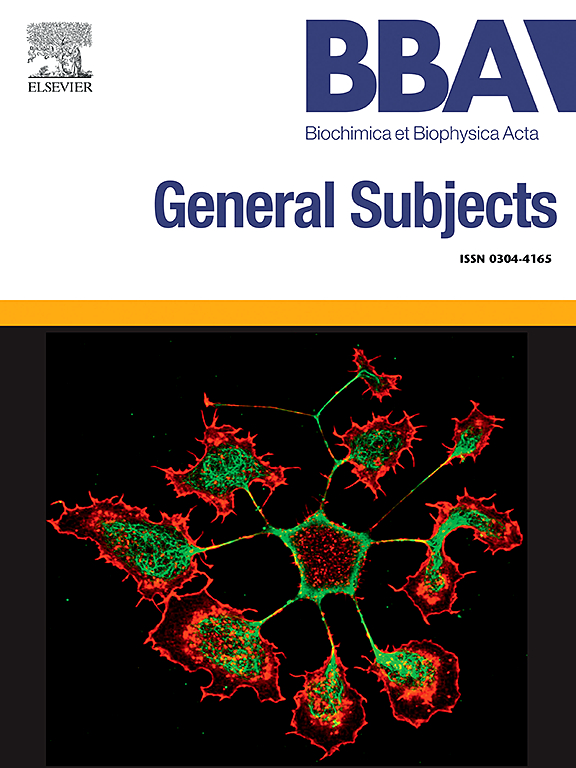SLAMF9通过激活海马-叶波通路加重心肌缺血再灌注损伤。
IF 2.2
3区 生物学
Q3 BIOCHEMISTRY & MOLECULAR BIOLOGY
Biochimica et biophysica acta. General subjects
Pub Date : 2025-05-16
DOI:10.1016/j.bbagen.2025.130821
引用次数: 0
摘要
背景:目的是研究信号淋巴细胞活化分子家族成员9 (SLAMF9)对心肌梗死(MI)的影响及其机制。方法:首先测定心肌梗死大鼠中SLAMF9的表达。采用超声心动图、HE染色、masson染色、小麦胚凝集素染色、western blot、TUNEL染色、qRT-PCR等方法探讨SLAMF9对心肌梗死大鼠心功能、心肌纤维化、心肌细胞肥大、心肌细胞凋亡及炎症的影响。同时通过CCK-8法、TUNEL染色和western blot检测SLAMF9对H9C2细胞活力、凋亡和炎症的影响。此外,采用western blot、ELISA和TUNEL染色等方法研究不同处理后SLAMF9的潜在作用机制。结果:心肌梗死大鼠中SLAMF9表达上调。SLAMF9敲低可改善心肌梗死大鼠的心脏损伤、心肌细胞凋亡和炎症反应。同样,巨噬细胞中SLAMF9的沉默可以减轻H/ r诱导的H9C2细胞的凋亡和炎症反应。此外,在体外和体内实验中,SLAMF9敲低可抑制心肌梗死的Hippo-Yap通路。此外,巨噬细胞中SLAMF9敲低可通过抑制TNF-α释放抑制H9C2细胞中hipo - yap通路的激活。此外,LATS1在H9C2细胞中的过表达逆转了SLAMF9沉默对H/ r诱导的H9C2细胞凋亡和炎症反应的影响。同时,PY-60处理H9C2细胞逆转了SLAMF9过表达对H/ r诱导的H9C2细胞凋亡和炎症反应的影响。结论:SLAMF9缺失导致巨噬细胞分泌TNF-α减少,从而抑制心肌细胞的Hippo-Yap通路,最终改善心肌梗死的心肌损伤、心肌细胞凋亡和炎症。本文章由计算机程序翻译,如有差异,请以英文原文为准。
SLAMF9 aggravates myocardial ischemia reperfusion injury through activating the hippo-yap pathway
Background
The objective was to investigate the impact of signaling lymphocyte activation molecule family member 9 (SLAMF9) on myocardial infarction (MI) and its mechanisms.
Methods
SLAMF9 expression in MI rats was firstly measured. SLAMF9 effect on cardiac functions, myocardial fibrosis, cardiomyocyte hypertrophy, cardiomyocyte apoptosis and inflammation in MI rats was explored using echocardiography, HE staining, masson staining, wheat germ agglutinin staining, western blot, TUNEL staining and qRT-PCR. Meanwhile, SLAMF9 effect on the viability, apoptosis, and inflammation in H9C2 cells was investigated by CCK-8 assay, TUNEL staining and western blot. Moreover, the potential mechanisms of SLAMF9 were investigated using western blot, ELISA and TUNEL staining after different treatment.
Results
SLAMF9 expression was upregulated in MI rats. SLAMF9 knockdown ameliorated heart damage, cardiomyocyte apoptosis and inflammatory response in MI rats. Similarly, SLAMF9 silencing in macrophages attenuated the apoptosis and inflammatory response in H/R-induced H9C2 cells. Moreover, SLAMF9 knockdown inhibited Hippo-Yap pathway in MI in vitro and in vivo. Besides, SLAMF9 knockdown in macrophages suppressed the activation of Hippo-Yap pathway in H9C2 cells by inhibiting TNF-α release. Additionally, LATS1 overexpression in H9C2 cells reversed the effect of SLAMF9 silencing on the apoptosis and inflammatory response in H/R-induced H9C2 cells. Meanwhile, PY-60 treatment in H9C2 cells reversed the effect of SLAMF9 overexpression on the apoptosis and inflammatory response in H/R-induced H9C2 cells.
Conclusion
The absence of SLAMF9 led to a reduction in TNF-α secretion in macrophages, consequently repressing Hippo-Yap pathway in cardiomyocytes, and ultimately ameliorating myocardial damage, cardiomyocyte apoptosis and inflammation in MI.
求助全文
通过发布文献求助,成功后即可免费获取论文全文。
去求助
来源期刊

Biochimica et biophysica acta. General subjects
生物-生化与分子生物学
CiteScore
6.40
自引率
0.00%
发文量
139
审稿时长
30 days
期刊介绍:
BBA General Subjects accepts for submission either original, hypothesis-driven studies or reviews covering subjects in biochemistry and biophysics that are considered to have general interest for a wide audience. Manuscripts with interdisciplinary approaches are especially encouraged.
 求助内容:
求助内容: 应助结果提醒方式:
应助结果提醒方式:


